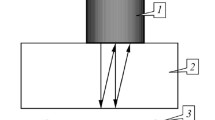Abstract
The acoustic emission method for estimating damage to specimens made of thermally resistant steel is described as applied in air and in a gaseous hydrogen medium. Acoustic diagrams (AD) of steel cracking and their interpretation are presented. It is shown that thermal cycling of the steel in air and in a hydrogen medium leads to an increase in bulk damage to the steel. It is shown that the exploited material is more subject to micro- and macrocracking under the influence of temperature and the working environment.
Similar content being viewed by others
References
Student, O.Z., Accelerated Method of Hydrogen Degradation of Structural Steels, Fiz.-Khim. Mekhanika Materialov, 1998, no. 4, pp. 45–52.
Kolachev, B.A., Vodorodnaya khrupkost’ metallov (Hydrogen Brittleness of Metals), Moscow: Metallurgiya, 1985.
Archakov, Yu.I., Vodorodoustoichivost’ stali (Hydrogen Resistance of Steel), Moscow: Metallurgiya, 1979.
Gel’d, P.V., Ryabov, R.A., and Kodes, E.S., Vodorod i nesovershenstva struktury metalla (Hydrogen and Imperfections of the Structure of Metal), Moscow: Metallurgiya, 1979.
Galaktionova, N.A., Vodorod v metallakh (Hydrogen in Metals), Moscow: Metallurgiya, 1967.
Tkachev, V.G., Problems of Hydrogen Degradation of Metals, Fiz.-Khim. Mekhanika Materialov, 2000, no. 4, pp. 7–14.
Mekhanika razrusheniya i prochnost’ materialov: Sprav. posobie v 4 t. (Mechanics of Fracture and Strength of Materials. Handbook), Kiev: Naukova dumka, 1988.
Panasyuk, V.V., Mekhanika kvazikhrupkogo razrusheniya materialov (Mechanics of Quasi-Brittle Fracture of Materials), Kiev: Naukova dumka, 1991.
Andreikiv, O.E., Mathematical Modeling of the Processes of Hydrogen Fracture of Metals, Fiz.-Khim. Mekhanika Materialov, 1997, no. 4, pp. 53–64.
Andreikiv, O.E. and Rudavskii, D.V., Calculation of the Service Life of a Component of a Pipeline under the Effect of Hydrogen-Containing Media, Fiz.-Khim. Mekhanika Materialov, 1999, no. 4, pp. 43–48.
Andreikiv, O.E., Rudavskii, D.V., and Gembara, O.V., Mathematical Model of Propagation of Fatigue Cracks in Hydrogenised Welded Joints, Fiz.-Khim. Mekhanika Materialov, 2002, no. 6, pp. 18–24.
Geller, W. and Sun, T., Influence of Alloy Additions on Hydrogen Diffusion in Iron and Contributions to the System Iron-Hydrogen, Arch. Eisenhuttenw, 1950, vol. 21, pp. 423–430.
Johnson, E.W. and Hill, M.L., The Diffusivity of Hydrogen in Alpha Iron, Trans. AIME, 1960, vol. 218, pp. 1104–1112.
Hobson, J.D., The Diffusion of Hydrogen in Steel at Temperatures of −78°C to 200°C, LSI, 1958, vol. 189, p. 315–321.
Metal Handbook, ASM International, OH: Metal. Park, 1948, p. 1208.
Pokhmurs’kii, V.T. and Fedotov, V.V., The Effect of Hydrogen on Diffusive Processes in Metals, L’viv: Enei, 1998.
Skalskii, V.R. and Koval, P.M., Some Methodological Aspects of Application of Acoustic Emission, L’viv: Publishing House Spolom, 2007.
Skal’s’kii, V.R., Sergienko, O.M., and Selivonchik, T.V., Calculation and Optimization of Geometry of a Waveguide of Signals of Acoustic Emission, Mashinoznavstvo, 2005, no. 9, pp. 41–45.
Andreikiv, O.G., Skal’skii, V.R., and Lisak, M. V., Patent Ukraini No. 2914. MPK:G01N29/14. Sposib kontrolyu rostu trishchin u zrazkakh materialiv, (A Method of Testing of Propagation of Cracks in Specimens of Materials. Patent of Ukraine, No. 2914. MPK: G01N29/14), Bull. 5’o1, 1994.
Skal’s’kii, V.R. and Adreikiv, O.G., Otsinka Ob’yomnoi Poshkodzhenosti Materialiv Metodom Akustichnoi Emisii, (Estimation of Bulk Damage to Materials by Acoustic Emission Technique), L’viv: Vid. LNU im. I. Franka, 2006.
Nazarchuk, Z.T., Koshovii, V.V., Skal’s’kii, V.R., et. al., Mekhanika ruinuvannya i mitsnist’ materialiv. Dovidnikovii posibnik, pod. zag. red. Panasyuka, V.V. t. 5, Neruinivnii kontrol’ i tekhnichna diagnostika, Pid. red. Nazarchuka, Z.T., (Mechanics of Fracture and Strength of Materials, Ed. Panasyuk, V.V., vol. 5, Nondestructive Testing and Technical Diagnostics, Ed. Nazarchuk, Z. T.), L’viv: FMI, 2001.
Andreikiv, O.G., Skal’s’kii, V.R., and Sulim, G.T., Teoretichni osnovy metodu akustichnoi emisii v mekhanitsi ruinuvannya, (Theoretical Fundamental Basis of the Method of Acoustic Emission in Fracture Mechanics), L’viv: Spolom, 2007.
Skal’s’kii, V.R., Rudavs’kii, D.V., and Selivonchik, T.V., Otsinka kontsentratsii ta molekulyarnogo tysku vodnyu v metali za termotsiklyuvannya, Zb. Prats’ 4-I Mizhnar. Konf. “Vodneva Ekonomika I Vodneva Obrobka Materialov VOM-2007, (Estimation of Concentration and Molecular Pressure of Hydrogen in Metal during Thermal Cycling, Proc. of Fourth Int. Conf. “Hydrogen Economy and Hydrogen Treatment of Materials VOM-2007”), Donetsk, May 21–26, 2007, p. 815–819.
Author information
Authors and Affiliations
Corresponding author
Additional information
Original Russian Text © V.R. Skal’skii, D.V. Rudavskii, T.V. Selivonchik, 2009, published in Defektoskopiya, 2009, Vol. 45, No. 9, pp. 56–69.
Rights and permissions
About this article
Cite this article
Skal’skii, V.R., Rudavskii, D.V. & Selivonchik, T.V. Hydrogen degradation of steel 12X1MΦ and its estimation by the acoustic emission method. Russ J Nondestruct Test 45, 636–645 (2009). https://doi.org/10.1134/S1061830909090071
Received:
Published:
Issue Date:
DOI: https://doi.org/10.1134/S1061830909090071




